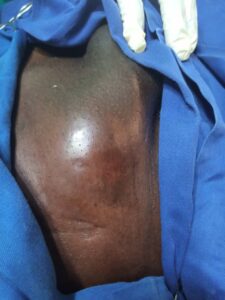

Subcutaneous abscess: as the name implies, subcutaneous abscess refers to the collection of pus within the dermis or subcutaneous tissue which may be due to bacterial infection. The region becomes swollen, soft with a translucent fluid, present under the skin.
This condition often presents a painless symptom as the beginning but gradually becomes worse most especially if it occurs around the joint where there is an active movement of bones.
Causes of subcutaneous abscess
- Bacteria
The Staphylococcus aureus has been known as the chief causative organism of subcutaneous abscess. As captured above, the abscess may be as a result of bacterial infection which occur when bacteria enter the body either by secondary infection or hair follicle
Unfortunately, the following people are more at risk of bacterial infection
- In close contact with a person with staph bacteria
- A diabetes patient – the condition would have weakened the immune system
- Poor hygiene practices
- Folliculitis
Infected hair follicles, or folliculitis, may cause abscesses to form in the follicle. Follicles can become infected if the hair within the follicle is trapped and unable to break through the skin, as can happen after shaving.
Folliculitis may also occur after spending time in an inadequately chlorinated pool or hot tub.
Symptoms of subcutaneous abscess
An abscess often appears as a bump on the skin, similar to a pimple. However, it can grow over time and resemble a cyst filled with fluid. Depending on the cause of the abscess, other symptoms may also be present. These symptoms may include:
- fever
- nausea
- chills
- swelling
- lesions on the skin
- inflamed skin
- fluid drainage from the abscess
The area around the abscess may also feel painful and warm to the touch.


Related complications of a subcutaneous abscess
In some cases, an abscess may cause serious complications. These may include:
- The spread of the infection, potentially to the brain or spinal cord
- Blood poisoning, or sepsis
- Endocarditis, which is an infection of the inner lining of the heart
- The development of new abscesses
- Tissue death in the area of the abscess, such as gangrene
- An acute bone infection, or osteomyelitis
Possible treatments for subcutaneous abscess
The treatment can be broadly divided into two, meanwhile, the present state of the condition spelled clearly the most suitable approach.
- Home treatment options
This is also be advised to do if the situation is still mild, it involves the application of heat to the region in order for the swollen to shrink and possibly heal up.
- Drainage
This is only done by a medical expert; it involves draining the fluid medically after ensuring that the process has a negligible chance of giving rise to a secondary infection. You are strongly counseled to visit our hospital if need be for drainage so as to avoid avoidable complications.
- Antibiotics
The use of potent antibiotics in treating severe cases of subcutaneous abscesses have also been of tremendous gain, this method is mostly used if the abscess occurs:
- on the face, which has a higher risk of causing complications
- as cellulitis
- as a multiple abscesses (more than one abscesses)
- under a compromised immune system
Preventive means of subcutaneous abscess
As they say, prevention is better than cure, therefore, it necessary to geared efforts towards avoiding the infection as much as we can. The following may be done to safe stay of subcutaneous abscess:
- Regular and frequent hand washing
- Clean all cuts and scrapes, even small ones, with soap and water and apply an OTC antibacterial ointment.
- Keep your cuts and wounds bandaged.



Recent Comments